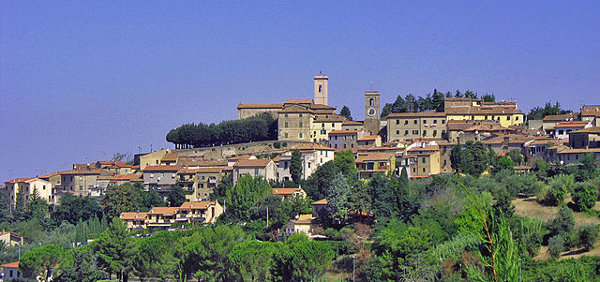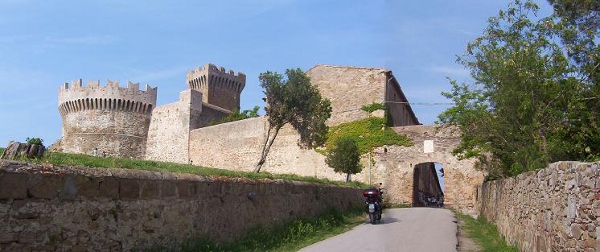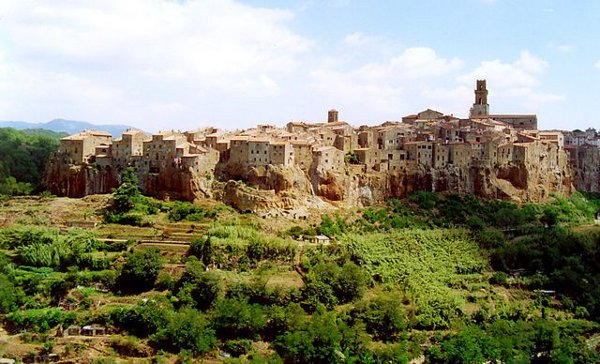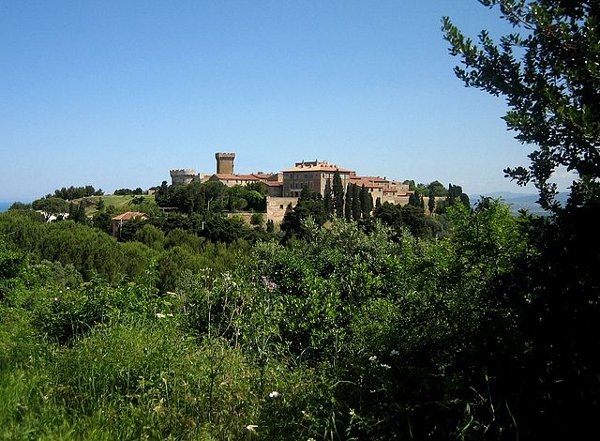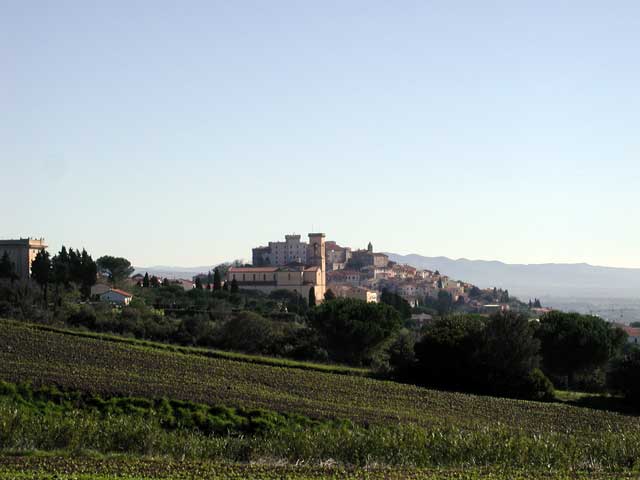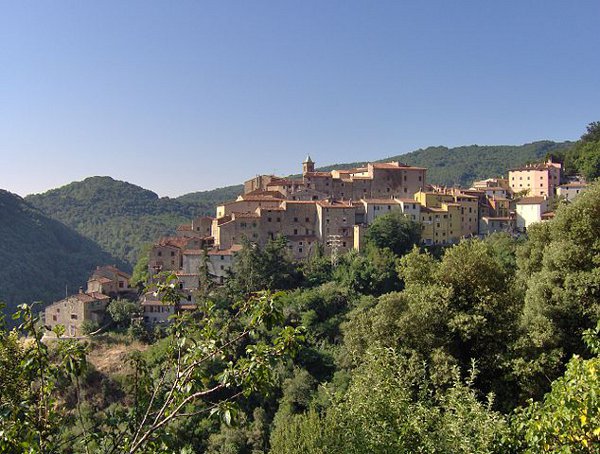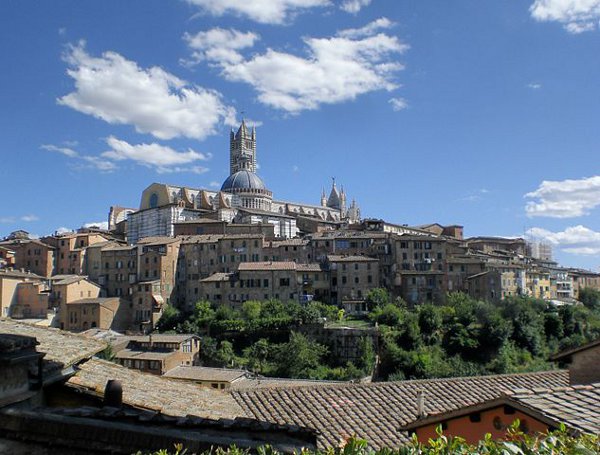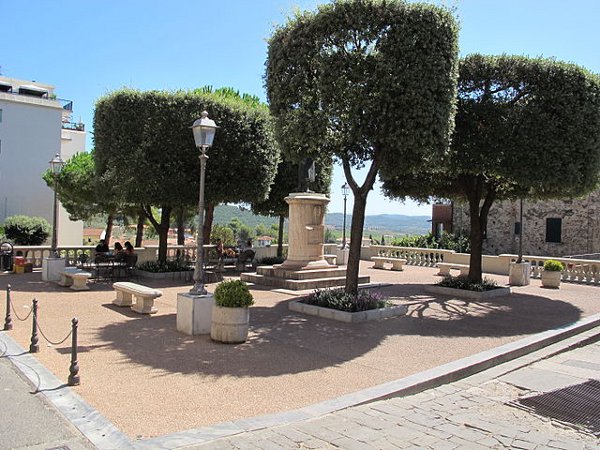Uncertain is the origin of Pisa, there are many theories about the foundation of this city in any case one of the oldest in Italy.
The plain on which it stands, which stretches from the slopes of Mount Pisano to the mouth of the Arno, was characterized by swamps, and the mouth of the River formed a large bog, encouraging a natural shelter for the boats and the birth and development of the city.
Dionisio Alicarnasseo Pisa describes how rich and flourishing, by the time they arrived the Pelasgians.
Cato, in his Origins, speaks of it as one of the oldest cities and Pliny in his Natural History attributes the foundation of the city to the Flats Alfei Pelasgians, commanded by Pelops, about three centuries before the Trojan War. Even Solinus says: "Who does not know that by Pelops in Pisa?". Virgil claimed that Pisa, of Etruscan origin, sent a thousand men to the aid of Aeneas, as he passed in Italy, after the destruction of Troy.
Strabo adopts two hypotheses, attributing the foundation is to Tarconte, the main
exponent of Etruscan mythology, both Pisei of the Peloponnese which, in the siege of Troy, were commanded by Nestor.
According to these theories, the origin would be from 1600 BC to 600a.C, the oldest if it relates to the Pelasgians, more recently, in relation to the Ligurians or Etruscans. All of these assumptions are based in each case on the writings dating back to a much later period, therefore, as to the reliability, we must admit that becomes somewhat problematic. "As may be inferred from smoke fire, only one draws the certainty of very remote antiquity to our city" as commented Tronci about the foundation of Pisa. Given the structure of the swampy territory also archaeological remains have never been so numerous and consistent to debunk or prove one of them.
The fact is that the city was built at the mouth of the Arno river close between this and the Serchio surrounded by wetlands that extended throughout the present plain.
He had various names, from a primitive to a later Teuta Alfea, but the present name derives from the Etruscans, who Pise, with the meaning of the mouth, indicating the probable scattered nuclei that formed as a whole, the city, and this would also explain the Latin plural of the title taken following: Pisae.
The core began to develop in particular thanks to the port and trade via mare.Difficile is also locate the exact spot where had to be the port of Pisa. Roughly one wants to just north of Livorno, the area now identified with Calambrone and Pond, adjacent to the current practice in the port labronico.
With the passage of time, and perhaps because of the continual silting, the harbor had become so narrow that at times medioevaleeste assumptions and determine with certainty the location of the first settlement
it could be closed, and as it were fenced with chains to prevent the enemy could enter.
A nothing, however, this measure was used in 1342, when the Genoese, with a surprise move, before they could pluck up the chains and then occupy the port. The chains, then donated to the Florentines, to have formed along a prestigious trophy of war, and now are hung on a wall of the Monumental Cemetery of Pisa.
Del Porto and related trades very well versed Lucan and Livy, and so described it in verse the poet Rutilius Numanziano: "Portum quem fame frequentat Pisarum emporium divitusque maris". The prosperity came for the trade based mainly on grapes, wheat, spelled, and the timber that came across the Arno from the Casentino
Pisa supplied throughout the Mediterranean, and imported from the East.
With the Etruscan domination began to establish business with the rich hinterland that was headed to the flourishing Velathri, Volterra, further strengthening an already established industry.
This wealth of commercial thoroughfares brought Pisa to have relationships with all the major civilizations of the Mediterranean, also culturally enriching, and formandogli with the knowledge, experience and the desire for autonomy, the natural originality that has characterized throughout its history.
In the third century BC the incursions of the Ligurian became more and more frequent, and greatly hinder the maritime trade and undermining the stability and security of the inhabited. Pisa so he decided to go under the protection of Rome.
It became an outpost of the Capital and was a basic element in the war of Rome against the Gauls, the Carthaginians and the Ligurians.
The war between them and the Romans, which took place in the city at the mouth of the Arno lasted several years, and lived alternately, until the decisive victory Capitoline, in 180 BC Pisa became a Roman colony, with wide autonomy, and began their seaborne trade more consistently, although their prestige, inland, was increasingly overshadowed by the growing power of nearby Lucca, overlooking the plain which stretched in front of Mount Pisano.
Nevertheless, a few years before the birth of Christ, Pisa began to take shape urbanistically quickly becoming one of the most prosperous cities of Italy, especially thanks to the efficiency of its port.
The remains of Roman civilization are numerous and scattered throughout the urbanized core and its surroundings. The most important remains are still the ancient baths, commonly called "Nero's baths".
47 of the Christian era dates back to the landing of the Apostle Peter who managed to take land at the mouth of the Arno roughly in that area today is called S. Piero a Grado, there seems to have founded a church, where is the current Basilica, and converted such a Pierino which was later consecrated as the first Bishop of Pisa.
Another event of the period was the beheading of a Christian Torpete, St. Torpoint, venerated as a Saint in Provence Tropez.
A few centuries later began the barbarian invasions, the invaders raged throughout the peninsula, spreading death and destruction everywhere, but Pisa was not affected as Rome, indeed, it was probably then that he laid the foundations for its development increased. .
Thanks to the conquests by sea, to the fame acquired, the importance of maritime trade, Pisa, around the middle of the sixth century had favorable conditions under Byzantine hegemony of Narses, who succeeded to the Huns.
Lucca was the seat of the rulers, and even the Lombards, who followed kept it as the cornerstone, leaving, however, a certain degree of autonomy to the port city.
Between the end of the century and in the age to come, was built a protection zone around the urban core.
Since 774 the Franks were to gain power, and an episode to mention is dating 828, when Count Boniface of Lucca, under the command of a ship and the Pisan fleet, inflicted a crushing defeat on Saracens, who raging throughout the Mediterranean .
The work of constant defense of the Tyrrhenian coast and sea trade by the Saracens, as well as the embankment of the advance Arab, was one of the salient and most famous in the history of Pisa.
The power center of Tuscia was still probably Lucca, Florence began to grow but also to consider while Pisa tried to distance themselves as much as possible, increasing by sea's wealth and fame
It seems that it is precisely thanks to this treasure that was entrusted to the architect Buscheto the task of starting the construction of the Cathedral in the great architectural complex known as the "Field of Miracles" and still is the symbol of Pisa.
More or less coeval to the Duomo is the construction of numerous Romanesque churches, which in some formal and structural characteristics are related to the greater monument, like the Church of San Frediano, the Church of San Michele degli Scalzi Church of San Zeno , the Church of St. Peter, the Church of the Holy Sepulchre, the Church of San Sisto and the Church of San Paolo a Ripa d'Arno, which is the most important constructive engagement for the city after the Cathedral.
In the second half of the century began to deteriorate relations with Genoa, which resulted with the conquest of the port of Rapallo, by Pisa, in 1075 and in a battle in front of the mouth of the Arno some time later.
On the death of Godfrey at the head of the feud Tuscan succeeded by his wife, the Duchess Beatrice, assisted by his son Godfrey "The Hunchback" and her young daughter Countess Matilde di Canossa, which for the death of both the joint, in 1076 he found himself only to manage one of the governments which was later considered among the most enlightened
In fact the firm, rather than a holy war, it was an economic character and power, not being very biblical messages in the agreement with the achievements at the cost of looting, death and destruction.
Pisa acquired a great importance, however, and although in Italy depended on the Emperor and was part of the Marquis of Lucca, was now the undisputed ruler of economic well-known throughout the Mediterranean having direct their fleets on the conquest of the most strategic for trade, which were later expanded.
Countess Matilda died in 1115, in Lucca, and began the decline of this city for the benefit of Florence, but began to glow with its own light the Maritime Republic of Pisa.
Came out recently from the most significant maritime conquest, one of the Balearic Islands, which in addition to the prestigious military value and paved the way for profitable trade and political relations with Aragon and Castile.
In 1118 the cathedral was consecrated by Pope Gelasius II, who confirmed the Archbishop of Pisa interference on Corsica, but exacerbating the conflict with Genoa.
Later, thanks to the intervention of Pope Innocent II, the two naval powers agreed in 1133 and are allied against the emerging Amalfi, in favor of the Emperor.
Pisa leaning always the imperial coat of arms, showing clearly its deep roots Ghibelline, though with the originality to maintain, with a skilful diplomacy, a certain detachment that would allow its autonomous action ........
It seems that it is precisely thanks to this treasure that was entrusted to the architect Buscheto the task of starting the construction of the Cathedral in the great architectural complex known as the "Field of Miracles" and still is the symbol of Pisa.
More or less coeval to the Duomo is the construction of numerous Romanesque churches, which in some formal and structural characteristics are related to the greater monument, like the Church of San Frediano, the Church of San Michele degli Scalzi Church of San Zeno , the Church of St. Peter, the Church of the Holy Sepulchre, the Church of San Sisto and the Church of San Paolo a Ripa d'Arno, which is the most important constructive engagement for the city after the Cathedral.
In the second half of the century began to deteriorate relations with Genoa, which resulted with the conquest of the port of Rapallo, by Pisa, in 1075 and in a battle in front of the mouth of the Arno some time later.
On the death of Godfrey at the head of the feud Tuscan succeeded by his wife, the Duchess Beatrice, assisted by his son Godfrey "The Hunchback" and her young daughter Countess Matilde di Canossa, which for the death of both the joint, in 1076 he found himself only to manage one of the governments which was later considered among the most enlightened
In fact the firm, rather than a holy war, it was an economic character and power, not being very biblical messages in the agreement with the achievements at the cost of looting, death and destruction.
Pisa acquired a great importance, however, and although in Italy depended on the Emperor and was part of the Marquis of Lucca, was now the undisputed ruler of economic well-known throughout the Mediterranean having direct their fleets on the conquest of the most strategic for trade, which were later expanded.
Countess Matilda died in 1115, in Lucca, and began the decline of this city for the benefit of Florence, but began to glow with its own light the Maritime Republic of Pisa.
Came out recently from the most significant maritime conquest, one of the Balearic Islands, which in addition to the prestigious military value and paved the way for profitable trade and political relations with Aragon and Castile.
In 1118 the cathedral was consecrated by Pope Gelasius II, who confirmed the Archbishop of Pisa interference on Corsica, but exacerbating the conflict with Genoa.
Later, thanks to the intervention of Pope Innocent II, the two naval powers agreed in 1133 and are allied against the emerging Amalfi, in favor of the Emperor.
Pisa leaning always the imperial coat of arms, showing clearly its deep roots Ghibelline, though with the originality to maintain, with a skilful diplomacy, a certain detachment that would allow its autonomous action.
In 1188 he participated in the Third Crusade. By the thirteenth century continued economic development of the thriving town, who tried to give himself an original legal-administrative decentralization of power.
The public body was headed by the Mayor, accompanied by the Captain of the People subjected to him, with the task of leading the militia and protect the people worse off by the nobility and the richer class.
The Captain of the People presided over the Council of Elders, the General Councils, the Council of the Thousand.
Soon resumed the bitter struggles with Genoa, more than anything else related to the domain of Corsica and Sardinia, and there were ups and downs between the two bitter rivals. Meanwhile in Pisa taking root authority of Count Ugolino della Gherardesca. He was able to connect their Ghibelline faith with the ideals of the powerful Guelph his son, Giovanni Visconti, Judge of Gallura, who joined him in the government of the Republic. This policy contrasted with the matrix that had always characterized the politics and ideals of the city, so that in 1274 the two rulers were banished from the city, which is why the Count Ugolino devastated the countryside, spreading terror, with the support of Charles of Anjou and the troops Lucca and Florence, and brought some victories against the militias of Pisa. These were later forced to surrender, yielding some castles to Lucca and the Florentines and accepting the return of Count within the walls. The greatest danger, however, came from the sea, in fact the rivalry with the powerful Ligurian city was accentuated more and more tragic and culminating in the crushing defeat of the Pisan fleet island of La Meloria, off the coast of Livorno, August 6, 1284 . For the Republic and his pride was a real defeat, so that we coined the saying, "Who wants to see Pisa go to see her prisoner in Genoa."
The terms of surrender were terrible and after the Meloria Pisa lost all importance as a maritime city and commercial Prisoners Pisa, Genoa, were thousands of them, and given the law that prevented women to remarry until her husband was dead, the damage a demographic that the city suffered, it was probably one of the main causes of future defeat.
Only the diplomatic skills that had always characterized the people of Pisa, and the experience acquired, managed to sustain the fortunes of the city, which you could not bend permanently although the decline was advancing inexorably.
The Elders of the Imperial Vicar appointed Podestà of Genoa, Uguccione Faggiola, which lifted the fortunes of the city, pushing even the conquest of Lucca.
In 1315 brought a great victory against the League Guelph, on August 29 in Montecatini.
But his ambitions were fatal to the power of the city and ended up seating itself dislodge the government Gaddo della Gherardesca.
He was able to bring peace with the most powerful cities in Tuscany, and also of his son married the daughter of Castruccio Castracani, Lord of Lucca, tightening so a link with the nearby town that always had been a bitter enemy.
Unfortunately Gaddo died in 1320, depriving the city of a presence that had been able to reconstruct important alliances, which however did not have followed.
If it was a period of internal restructuring, and notable works of fortification, with walls and towers for defense, however, was approaching a time rather negative politics.
Targeted by sea, the port and threatened almost inefficient dall'insabbiamento caused by the Arno, Pisa was surrounded by city traditionally rivals, who isolated it from the reference imperial detached itself more and more.
Collapsed so, the prerogative of Florence, the glorious maritime republic on 9 October 1409.
Pisa definitively lost its freedom, except for a brief parenthesis at the turn of the fourteenth and fifteenth centuries.
The political and economic decline is irreversible, produced a significant depletion of the great constructive engagement so that in the fourteenth century the only important religious construction was the church of Santa Maria della Spina, on the Lungarno Gambacorti, and in the context of civil Palace Gambacorti.
In sharp demographic decline, economically exhausted, but the city still retained all the cultural characteristics of a cosmopolitan city, so much so that in 1409 it was chosen as the site for a Council.
He began a new phase for the city, that of awe, never felt before.
The Florentine nobles aimed mainly to strengthen the defense of your domain building fortifications around the city, such as the complex of Stampace-Porta a Mare, the Citadel Old and New, the Bastion of Parlascio that would have been even designed by Filippo Brunelleschi.
With the advent of the Medici to the pinnacle of power lilies began, however, a period of economic recovery, social and even cultural, thanks to the Enlightenment ideals and development of the territory of the rulers.
This led to the end of the century, when the city, driven by the arrival of Charles VIII, resumed its independence, albeit supervised by the king of France.
Also promised their help to the independence of Pisa, the Duke of Milan, Emperor Maximilian of Austria, the Republic of Venice, in 1496 giving the support of his troops.
Pisa found himself again the protagonist, regaining many castles, but was at the mercy of the interests of three Allied powers who had designs on the city, and seeing the opportunity to excel, they abandoned to their fate.
The Florentines soon regained the lost positions, and girded siege in the city on the Arno.
The siege lasted several years, with several failed assaults, inside the walls they fought heroically, and florins were unable to have the upper hand, until, through a tentative agreement with the King of France and Spain, and with neighboring cities , failed to isolate both politically and materially Pisa, as with the siege were blocked all roads, including the Arno and other waterways
The new Grand Duke is also very dedicated to the development and the raising of the university, and he should be recognized a particular fondness for Galileo Galilei, who was appointed First Mathematician and Philosopher.
Cosimo II died just thirty-two years in 1621, leaving a serious gap in terms of personality that was not filled by any of the successors.
With Ferdinand II began the neglect of the town which, in 1630, was hit by the epidemic pestilence which decimated the population in the whole peninsula.
Only in recent years, the Grand Duke pointed to a cultural revival of the University, thus resuming a little 'personal prestige.
From 1670 he was succeeded by Cosimo III, who was certainly the most immobile of the Grand Duchy, now divided into fiefdoms and abandoned in a uniform policy and loose, the disinterest of the vertices of the domain.
A Gian Gastone succeeded by Cosimo III, who was the last of the Medici.
From 1737 took the reins of the Grand Duchy of Lorraine, of which the first was Francis II.
The situation in Pisa began to improve thanks to the sense of responsibility and industriousness of the new rulers.
Within the walls were made considerable improvements, and enthusiasm for the new rulers grew up, seen the renewed interest in the fate of the city and the countryside.
Following Cosimo founded the Office of the Rivers and Fossi, and he devoted much of interventions bonificadel territory and to initiatives to raise the social, political and cultural life of the city and its surroundings. In 1548 came the estate of S. Redness, expressed wish of Eleonora of Toledo, wife of Cosimo, while in 1560 it was started Navicelli Canal, which connected the mouth of 'Arno with the port of Livorno, as the grand-ducal city in the outlook would have to provide a forum merchant to complement the Livorno port of call. Also in 1571 a Pisan fleet, or rather Medici, participated in the victorious Battle of Lepanto against the Turks
As a result of power struggles that were upsetting the whole of Europe, the Grand Duke preferred to leave their domain, taking refuge in Germany.
Pisa was thus at the mercy of Bourbon-Parma, then under Elisa Bonaparte Baiocchi, and finally directly under the aegis of the French Imperial, which ended in 1814, with the defeat of Napoleon.
Restoration began with the return of Ferdinand III, highly acclaimed by the people.
A Ferdinand III was succeeded, in 1824, Leopold II, who distinguished himself who was also in the works of internal restructuring, but mainly in the reclamation and improvement of waterways and lines of communication with the opening of the railway sections for Livorno, Florence and Lucca, who came to revive
the function of road junction of great importance that Pisa had played since ancient times .. In 1846 also the capital suffered damages due to the earthquake that took the epicenter Lower Pisan Hills.
In the city began to pull air of rebellion, had formed numerous secret societies, the atmosphere was tense and certainly did not presage a period of tranquility for the vertices of the Grand Duchy.
After settling uncertain due to the Wars of Independence, February 27, 1859 Leopold II left Tuscany, and a year later there was a plebiscite for annexation to the Kingdom, which saw 12,049 voters in Pisa in favor of 12,285.
Thus began the modern phase of the city's history.
In the following years there was a radical transformation of the urban fabric with the birth of several buildings and the dismantling of many structures of medieval times which gave a new configuration to the city
The March 10, 1872 Giuseppe Mazzini breathed his last in this city where he lived for some time under a false name.
At the beginning of our century Pisa was one of the most active cities of Italy, both from an economic point of view that cultural
This led many industries, among which we distinguish the Saint Gobain, precious glassware still active, and the factory of Richard Ginori ceramics, was developed in the textile industry, in particular that of the cotton mill, and there were many craft businesses
They were the designers of equipment, brothers Antonio and give life to the airport in 1911, it began to increase its activities, both civilian and military.
During the Second World War, the city has paid the contribution of well-sad 1824 dead and many were damaged and destroyed buildings from the relentless bombardment to the damage he joined the overflowing of 'Arno of November 1944, which was yet another blow to the already disaster perpetrated.
The works of reconstruction began immediately, thanks to the spirit of revenge and the strength of will that has never left this town, and within a few years had been rebuilt the bridges destroyed by the Germans as the main structures damaged
Today, Pisa is a city with an economy geared towards many areas.
In the area of Ospedaletto has developed an important, broad and diverse area industrial and artisanal
L 'Galilei Airport is undoubtedly the region's main
There are some barracks of the most efficient of Italy, and between the city and the coast, in the bolster, behind Tirrenia is situated Camp Darby, a logistics base of the U.S. Armed Forces, among the most important in Europe , which serves mainly as storage and refueling of U.S. troops stationed in Italy and other parts of Europe.
In the area of Barbaricina, adjacent to Park St. Redness and the Hippodrome, are numerous stables and activities related to horseracing
It 'also important tourism, especially related to the influx in Piazza dei Miracoli, the recent discovery of relics in the ancient Roman naval port of Pisa and the summer season on the coast Pisano, with the many activities and tourist resorts of Marina di Pisa, Tirrenia and Calambrone.
Very active and efficient are the three hospitals of Santa Chiara and Cisanello Calambrone
They are to report the Military Applications Nuclear Energy Center, established in 1956, and the National University Computing of the National Research Council, which is present in Pisa with 13 institutes and 5 centers, more than specific importance that these structures play they also represent a significant source of employment.
The University of Pisa has some power at the national level that the rise culturally and moreover bring an economic benefit to the many students who flock daily or come to reside in the city.
It represents the real basis for relaunching Pisa, both from an economic point of view, that from a point of view and prestigious cultural
Thanks to the University who runs it together with the 'Municipal Administration, was created, and has been active since 1984, Palazzo dei Congressi, polo important city for the numerous international conferences and various events that in this modern and highly efficient headquarters are organized
With the arrival of numerous mercenary troops beginning in the pay of Florence, Pisa was able to slightly raise their own situation, regaining some of the castles strappatigli, especially with the help of the famous leader known as Giovanni Acuto.
As they had previously done with the Florentines, but the mercenaries proved to be very loyal to the interests of Pisa, which reported a heavy defeat at the Battle of Cascina, July 28, 1364.
The infighting between Raspanti Bergolini and tore more and more cities, already impoverished even by hijacking traffic of goods from Florence to Talamone, from 'political isolation and the loss of consistency in the maritime field.
It was the Gambacorti, who had previously driven to give a sigh of relief to the fate of Pisa and succeeded in getting agreements with Firenze, allowing a resumption of trade, so much so that he was appointed Captain General People's Defender and the Municipality of Pisa.
It was the only one able to use that ancient and cunning diplomacy, described above. Gian Galeazzo Visconti, Lord of Milan, plotted in the city at the mouth of the Arno, to counter the relations with rival Florence, and did so much that he hatched, October 21, 1392, murder of Gambacorti, bringing to power the D'Appiano . Gherardo d'Appiano, in 1399, "sold" to the Visconti the city of Pisa, with the lordship of Piombino and the islands, Elba, Montecristo and Pianosa, for 200,000 gold florins
https://tuscanysea.com/backoffice/immagini/tuscanysea.com/30-17-5-2013-11-42-181.jpg
https://tuscanysea.com/backoffice/immagini/tuscanysea.com/30-17-5-2013-11-42-182.jpg

